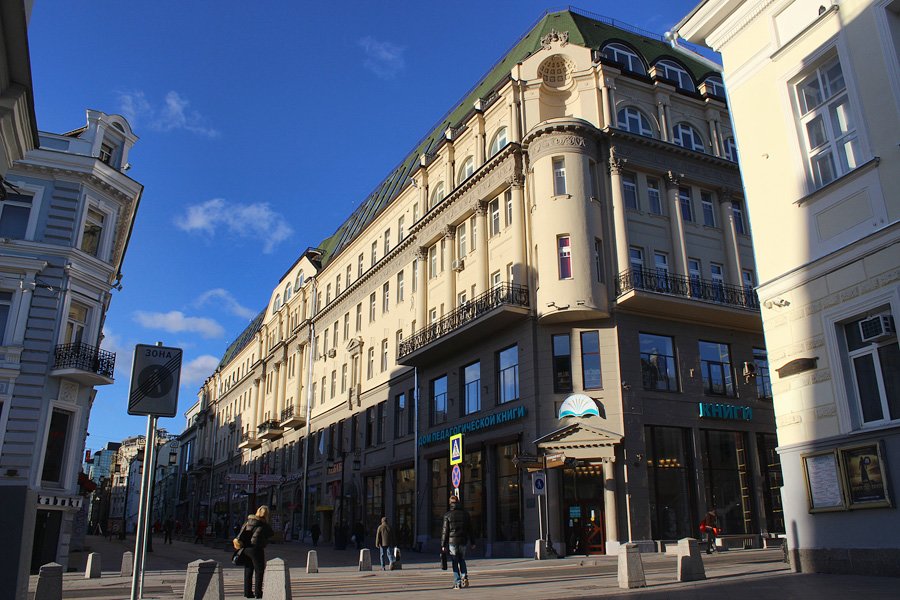Все, кто учился в советской Москве, знают этот большой дом из темного камня на углу Пушкинской и проезда Художественного театра. Здесь с 1945 года располагался магазин «Педагогическая книга», сюда приезжали за учебниками и контурными картами школьники из разных уголков столицы.
Доходный дом Е.А. Обуховой и князя С.С. Оболенского появился на углу Большой Дмитровки и Камергерского переулка в 1913-м, когда в Москве шло грандиозное строительство доходных домов. Проект дома принадлежал гражданскому инженеру В.А. Величкину, который с 1911 года занимал в Москве пост архитектора Московской конторы императорских театров.
Дом прекрасно оформляет угол, образованный улицей и переулком. Первые два этажа спланированы как магазин с угловым входом, оформленным классическим портиком. Полукруглый эркер и колоннада подняты на уровень третьего и четвертого этажа. Легкие ажурные балконы отделяют магазин от жилой части здания. Угол здания венчает полукруглая ниша, на которой установлен рельефный герб князей Оболенских, от ниши расходятся большие полукруглые окна, из которых открывался прекрасный вид на невысокую застройку Москвы начала ХХ века.
В разное время обширный угловой участок принадлежал Собакиным, Глебовым-Стрешневым, Хлудовым, Оболенским и Шаблыкину, московскому вице-губернатору. По Камергерскому переулку стоял один из флигелей усадьбы, выходящей парадным подъездом на Дмитровку.
Дом известен тем, что на третьем этаже в помещении Шахматного клуба с 4 по 24 октября 1920 года проходила Первая Всероссийская шахматная Олимпиада. Победителем Олимпиады стал будущий чемпион мира по шахматам А. А. Алехин.
В 1924 году первый этаж дома занимает оптово-розничный склад московского отделения торгсектора Госиздата СССР, с 1936-го это уже магазин «Просвещение», а с 1945-го - «Педагогическая книга». Сейчас название также поменялось на «Дом педагогической книги».
Мемориальные доски на стене здания напоминают о том, что здесь с 1921 по 1934 годы жил выдающийся русский оперный певец Л. В. Собинов, а также писатель Л. А. Кассиль.
В разные годы в доме проживали народные артисты СССР М. И. Прудкин, Н. П. Хмелёв, И. Н. Береснев, С. В. Гиацинтова, камерная певица, близкая знакомая С. В. Рахманинова Н. П. Кошиц, земский врач Н. И. Тезяков, останавливался писатель, автор романа «Тихий Дон» М. А. Шолохов.












%20BEL_0521.jpg&w=1920&q=75)





